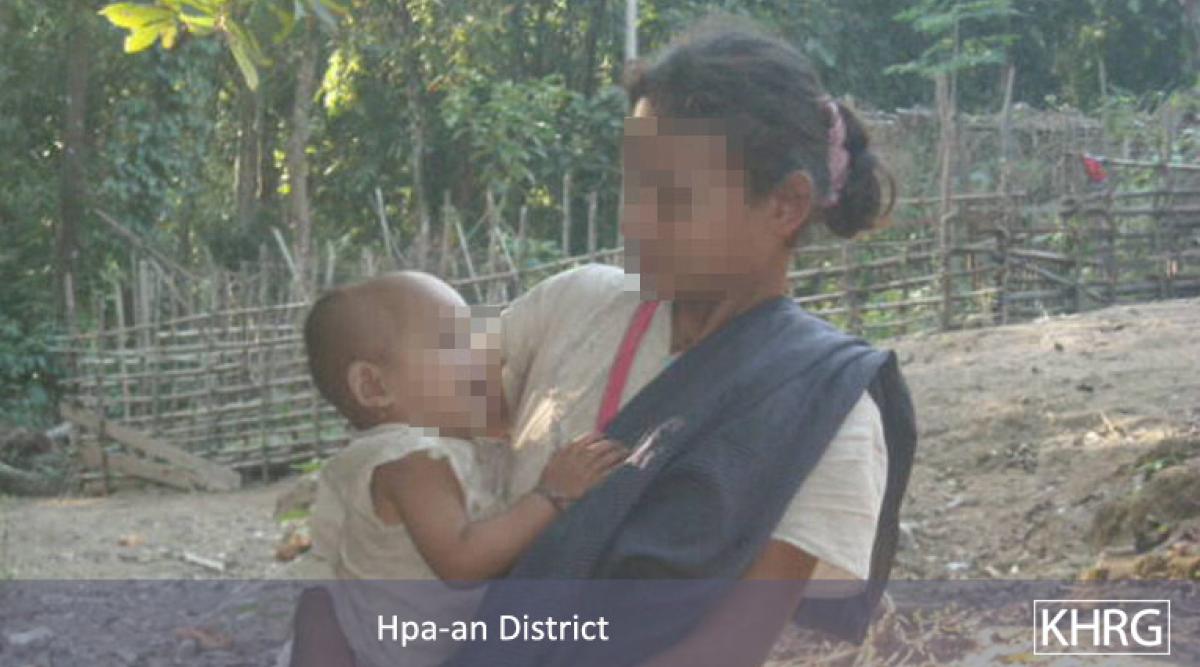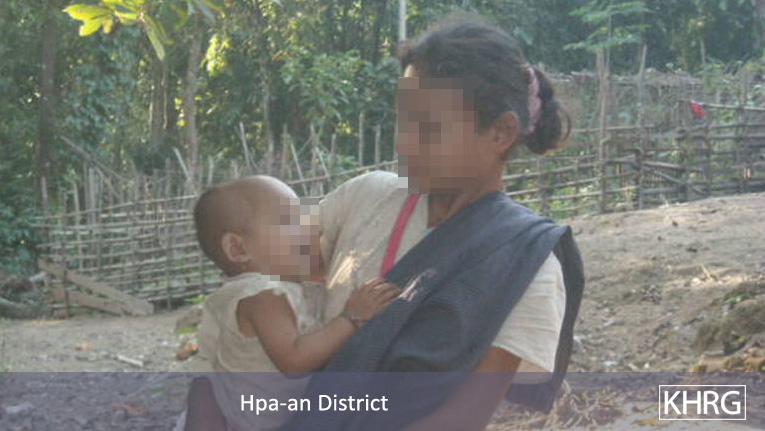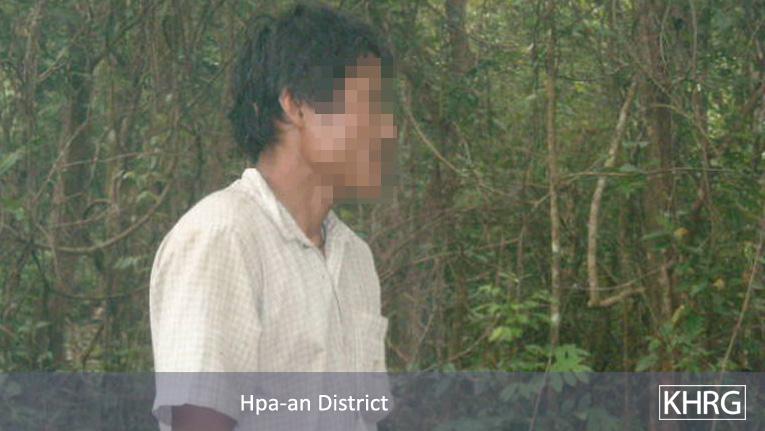On November 29th 2010 Saw T---, a 27-year-old man from Lu Pleh Township, Pa'an District was arrested, tortured and executed by soldiers from Tatmadaw Border Guard Force Battalion #1015, following accusations that he had made contact with and provided information to the KNU. In a separate incident that occurred on November 19th 2010 Saw M---, a 75-year-old man, was executed at point blank range by soldiers from a different unit of the same Border Guard Force Battalion #1015, after being asked to step outside his houses in Dta Greh Township, Pa'an District. This news bulletin is based on information KHRG received from Saw T---'s wife on February 1st 2011 and from saw M---'s son is mid-December 2010.
On February 1st 2011, Naw L---, 24, told KHRG that her husband, Saw T--- had been arrested, beaten and summarily executed by soldiers from Tatmadaw Border Guard Force (BGF) Battalion #1015,[1] led by Company Commander Mu Naw Dweh. According to Naw L--- the soldiers came to their house in Gk--- village, Lu Pleh Township, Pa’an District at around 7:00 pm on November 29th 2010, accused Saw T---, 27, of making contact with and spying for the Karen National Union (KNU), and arrested him. The arresting officer was Private Wah Lu. Naw L--- told KHRG that she was too afraid to leave the house after her husband was detained, but that she heard gunshots fired during the night. The next morning she went to look for him and found his dead body; Naw L--- said her husband’s body had two or three bullet wounds in the chest, and looked like he had been badly beaten before he was shot. Saw T--- was a member of the local school committee for Gk--- village. As a committee member, Saw T--- had had contact with the Karen Education Department (KED), the education department of the KNU, in order to secure support for and the provision of materials to the school in Gk--- village, which provides classes for children up to 4th standard. Saw T--- and Naw L--- have one son, aged three years old, and a daughter, aged one and a half years old. Naw L--- and her children are currently staying with relatives at an undisclosed location.
n a separate incident reported to KHRG in mid-December 2010, Saw M---, a 75-year-old resident of Bp--- village, Dta Greh Township, Pa’an District was shot at point blank range on November 19th 2010 by BGF Battalion #1015 troops that had been recently deployed in his village. Saw M---’s son Saw W---, 27, told KHRG that Saw M--- had a habit of pretending, when he was intoxicated, that he practiced ‘black magic’. Saw W--- said that local DKBA troops previously stationed in the Bp--- area had been familiar with Saw M---’s habits; he believed, however, that newly-arrived BGF Battalion #1015 troops viewed Saw M--- with suspicion and considered that he posed a security threat. Saw W--- told KHRG that, on November 19th 2010, Saw M--- was called out of his house by BGF soldier Pah Lay Koh, who shot and killed Saw M--- as soon as he stepped outside.
Suspicion of civilians by Tatmadaw forces has been previously documented to attend the escalation of hostilities between the Tatmadaw and non-state armed groups in mixed administration areas in eastern Burma,[2] as well as to accompany tensions between the Tatmadaw and various racial and religious minorities in other areas of Burma.[3] KHRG has documented numerous incidents in which civilians have been detained, abused, persecuted or summarily executed after being suspected of supporting, contacting or cooperating with the KNU or its armed wing, the Karen National Liberation Army (KNLA),[4] The extrajudicial arrest, abuse and execution of civilians on such grounds appear to be established, tacitly-sanctioned practices in areas over which Tatmadaw forces seek to extend or consolidate military control.[5] The execution of Saw W---, meanwhile, illustrates the danger, recently articulated by villagers confronting increasing conflict in Dooplaya and Pa’an, that re-orientation of military relationships or instability in the military context near their communities may expose civilians to acute suspicion and serious human rights violations by unfamiliar armed groups.[6]
Footnotes:
[1] BGF Battalion #1015 was previously DKBA Brigade #999. For more on the transformation of DKBA troops into Border Guard Force battalions and the origins of the current conflict, see “Protection concerns expressed by civilians amidst conflict in Dooplaya and Pa’an districts,” KHRG, November 2010.
[2] For this reason, the seizure of Myawaddy Town in Dooplaya District on November 7th 2010 by a breakaway faction of the DKBA prompted fears amongst civilians in the Waw Lay and Myawaddy areas that they would be suspected of supporting DKBA soldiers and subsequently arrested. See “Protection concerns expressed by civilians amidst conflict in Dooplaya and Pa’an districts”, KHRG, November 2010. For an explanation of mixed administration areas, see: Submission for the UN Universal Periodic Review: Human rights concerns in KHRG research areas, KHRG, July 2010.
[3] For further examples of racial and religious persecution in Burma, see Easy Targets: The persecution of Muslims in Burma, KHRG, May 2002; Progress Report of the Special Rapporteur on the situation of human rights in Myanmar, A/HRC/13/48, 10 March 2010 pp. 16 – 18; Crimes against Humanity in Western Burma: The Situation of the Rohingyas, Irish Centre for Human Rights, 2010; and The repression of ethnic minority activists in Myanmar, Amnesty International, February 2010.
[4] For recent examples, see: “Southern Papun District: Abuse and the expansion of military control,” KHRG, August 2010; “Southwestern Papun District: Transitions to DKBA control along the Bilin River,” KHRG, August 2010; “Attacks on cardamom plantations, detention and forced labour in Toungoo District,” KHRG, May 2010; “Living conditions for displaced villagers and ongoing abuses in Tenasserim Division,” KHRG, October 2009; “Livelihood consequences of SPDC restrictions and patrols in Nyaunglebin District,” KHRG, September 2009; “Oppressed twice over: SPDC and DKBA exploitation and violence against villagers in Thaton District,” March 2008; “SPDC soldiers arrest and kill villagers on allegations of contacting KNU/KNLA”, KHRG, January 2008. KHRG has also documented several incidents in which Tatmadaw soldiers have practiced extrajudicial arrest and abuse of villagers suspected of links to the DKBA, in the context of current conflict in Dooplaya and Pa’an districts; see: “Human rights abuses and obstacles to protection: Conditions for civilians amidst ongoing conflict in Dooplaya and Pa’an districts,” KHRG, January 2011.
[5] Local Tatmadaw personnel operating in eastern Burma have generally not explicitly cited any legal basis for the detention of suspected KNU affiliates. Burma's colonial-era Unlawful Associations Act 1908, under which the KNU has been defined as an "anti-government group" provides domestic legal basis for the detention of civilians who "assist the operations” of such a group; it is important to note, however, that many arrests and executions of civilians in eastern Burma occur entirely extra-judicially, without any reference to legal norms, statutory or otherwise. For more on the Unlawful Associations Act, see: Unlawful Associations Act 1908, Article 17 (1); “Submission to the UN Universal Periodic Review: Tenth Session of the UPR Working Group of the Human Rights Council,” Amnesty International, July 2010; “Submission by the Asian Legal Resource Centre to the Human Rights Council’s Universal Periodic Review concerning human rights and rule of Law in Myanmar,” Asian Legal Resource Centre, June 2010, paragraph 9; and: The repression of ethnic minority activists in Myanmar, Amnesty International, February 2010, endnote 50.
[6] See: “Protection concerns expressed by civilians amidst conflict in Dooplaya and Pa’an districts,” KHRG, November 2010.





